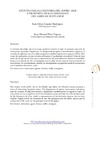Identificador persistente para citar o vincular este elemento:
https://accedacris.ulpgc.es/jspui/handle/10553/56236
| Campo DC | Valor | idioma |
|---|---|---|
| dc.contributor.author | Amador Rodríguez, Luis Alexis | - |
| dc.contributor.author | Pérez Vigaray, Juan Manuel | - |
| dc.date.accessioned | 2019-07-25T16:17:18Z | - |
| dc.date.available | 2019-07-25T16:17:18Z | - |
| dc.date.issued | 2018 | - |
| dc.identifier.issn | 0212-4130 | - |
| dc.identifier.other | WoS | - |
| dc.identifier.uri | https://accedacris.ulpgc.es/handle/10553/56236 | - |
| dc.description.abstract | La historia del sufijo -dor en la etapa medieval anterior al siglo xv presenta una serie de interesantes cuestiones lingüísticas. La designación de agentes, instrumentos y lugares y la creación de adjetivos con este sufijo comportan cambios importantes respecto al latín. Para tratar de explicarlos, en este artículo utilizamos el vocabulario extraído del Libro de buen amor, del Arcipreste de Hita, que es representativo del procedimiento derivativo estudiado. Junto a la evolución de -dor, la amalgama con el sufijo -dero/a centrará nuestra atención en este artículo. En este fenómeno, además, ha desempeñado un papel destacado la coalescencia con el morfema derivativo -ero/a. | - |
| dc.description.abstract | The history of the suffix -dor in the Middle Age before the fifteenth century presents a series of interesting linguistic issues. The designation of agents, instruments and places and the creation of adjectives involve a significant transformation in regard to Latin. In this article, we try to explain it with the vocabulary extracted from the Libro de buen amor by the Arcipreste de Hita, which is representative of the derivative process that we have studied. Together with the evolution of -dor, the amalgam with the suffix -dero/a and the coalescence with -ero/a are the principal aims of this paper. | - |
| dc.language | spa | - |
| dc.relation.ispartof | Revista de Filología de la Universidad de La Laguna | - |
| dc.source | Revista de Filología de la Universidad de La Laguna [ISSN 0212-4130], n. 37, p. 9-23 | - |
| dc.subject | 57 Lingüística | - |
| dc.subject | 570201 Lingüística histórica | - |
| dc.subject.other | Derivación | - |
| dc.subject.other | Agente | - |
| dc.subject.other | Historia | - |
| dc.subject.other | Sufijo | - |
| dc.subject.other | Amalgama | - |
| dc.subject.other | Suffix | - |
| dc.subject.other | Derivation | - |
| dc.subject.other | Agent | - |
| dc.subject.other | History | - |
| dc.subject.other | Amalgam | - |
| dc.title | Apuntes para la historia del sufijo -dor a propósito de los derivados del Libro de buen amor | - |
| dc.title.alternative | Notes about the history of the suffix -dor with regard to the Libro de buen amor | - |
| dc.type | info:eu-repo/semantics/article | - |
| dc.type | Article | - |
| dc.type | info:eu-repo/semantics/Article | - |
| dc.identifier.doi | 10.25145/j.refiull.2018.37.002 | - |
| dc.identifier.isi | 000461024100001 | - |
| dc.description.lastpage | 23 | - |
| dc.description.firstpage | 9 | - |
| dc.relation.volume | 37 | - |
| dc.investigacion | Artes y Humanidades | - |
| dc.type2 | Artículo | - |
| dc.contributor.daisngid | 3061173 | - |
| dc.contributor.daisngid | 11020885 | - |
| dc.description.numberofpages | 15 | - |
| dc.utils.revision | Sí | - |
| dc.contributor.wosstandard | WOS:Rodriguez, LAA | - |
| dc.contributor.wosstandard | WOS:Vigaray, JMP | - |
| dc.date.coverdate | Marzo 2018 | - |
| dc.identifier.ulpgc | Sí | es |
| dc.description.sellofecyt | Sello FECYT | |
| dc.description.esci | ESCI | |
| dc.description.fecytq | Q3 | |
| dc.description.fecytpuntuacion | 23,54 | |
| dc.description.dialnetimpact | 0,0 | |
| dc.description.dialnetq | Q1 | |
| dc.description.dialnetd | D2 | |
| dc.description.erihplus | ERIH PLUS | |
| item.grantfulltext | open | - |
| item.fulltext | Con texto completo | - |
| crisitem.author.dept | GIR Sociolingüística, fonética acústica y lingüística aplicada a la enseñanza | - |
| crisitem.author.parentorg | Departamento de Filología Hispánica, Clásica y de Estudios Árabes y Orientales | - |
| crisitem.author.fullName | Pérez Vigaray,Juan Manuel | - |
| Colección: | Artículos | |
Citas de WEB OF SCIENCETM
Citations
1
actualizado el 08-jun-2025
Visitas
91
actualizado el 10-ago-2024
Descargas
713
actualizado el 10-ago-2024
Google ScholarTM
Verifica
Altmetric
Comparte
Exporta metadatos
Los elementos en ULPGC accedaCRIS están protegidos por derechos de autor con todos los derechos reservados, a menos que se indique lo contrario.
